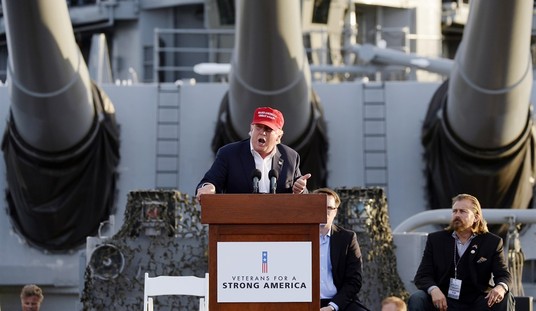A commenter in the Too Interconnected to Fail post asks if I could extend the analogy of the Second Naval Battle of Guadalcanal to the dangers of applying the wrong solution to the debt problem.
Wretchard, you briefly mentioned Kirishima’s sinking; it might be worth a column to describe how she essentially sank herself through very ill-considered counterflooding (I believe some time back you liked to the analysis). That would make a SUPERB analogy to these efforts to escape an imploding-debt crisis with still more debt.
The most complete discussion of the damage suffered by the IJNS battlecruiser that night is contained in an article by Robert Lundgren. Using recent surveys of the Kirishima wreck as a guide and re-analyzing the action reports of that night in 1942 Lundgren comes to the conclusion that USS Washington grossly underestimated the damage she inflicted on the battlecruiser.
Most older histories of the battle credited Washington with 9×16″ and 40×5″ hits on the Japanese battlecruiser, but the newer evidence shows that the real damage was 20×16″ and 15×5″. By correlating evidence from the wreck with the Japanese damage control officer’s logs and USN action reports, Lundgren produces a hit-by-hit narrative and plots the location of each strike.
To have been stricken by 9×16″ would have been bad enough, but the damage inflicted by 20×16″ underlines the fact that Kirishima was irretrievably doomed. She was opened like a tin can and would have gone to Davy Jones’ one way or the other. But that is not the whole story. What sped her to the briny deep was a combination of standard damage control procedures plus the unanticipated consequence of the “free surface effect” — sloshing water to us landlubbers — that ran rampage through undivided middle decks.
The USS Washington’s shells easily defeated the old battlecruiser’s armor and destroyed what internal subdivisions existed on her middle decks. The damage control officer, eager to correct a list, counter-flooded and the ship settled deeper in the water. What happened next was that thousands of tons of seawater entered the middle decks, which were now little more than a collander, and the shifts of this titanic mass created a gypsy list which the damage control officer sought to offset by flooding yet other parts of the ship. He was in some sense chasing a rubber ducky around a bathtub, except the rubber ducky was a massive flood of seawater and the bathtub was the Kirishima.
When the XO Commander Koro One ordered port voids flooded to correct the starboard list it only settled the ship lower in the water bringing her entire middle deck below the waterline and allowed the beginning of progressive flooding of the middle deck. When more progressive flooding occurred she will flip over to a port list and the XO ordered more starboard voids flooded which again simply settles the ship lower and allows more water onto her upper decks and she flops back to starboard. Eventually, flooding the port voids will not correct the starboard list but only increase the rate of flooding from starboard and the starboard list steadily grew.
The suddenness with which Kirishima died can be deduced from this timeline. USS Washington opened fire at 0100 hours. At 0107 — seven minutes later, Washington fired her last salvo. By 0125 Kirishima was gone. Twenty five minutes. In that short space thousands of Japanese sailors fought the ship as it churned along at near thirty knots, attempted to save their battlecruiser as it reeled under a rain of shells and finally tried to save themselves by going over the side into Ironbottom Sound. Sixty nine officers and 1,031 men were rescued by the destroyers after a frenzy of naval combat that is probably beyond the imagination of a 21st century man.
Did Kirishima sink herself? Lundgren argues that she hastened her demise. But ultimately she died from wounds no battleship could be expected to sustain and survive. What is truly impressive to the point of beggaring belief is the cool professionalism of the Japanese damage control officer who in the terrible confusion and stress of a ship being hit by major caliber shells at machine-gun rapidity, still found the wit to catalog and assess each frightening wound the Kirishima was taking.
Men — even brave men — even brave men fighting for their lives, can in the uncertainty and horror of stupefying events make mistakes which will lead to their deaths and all their shipmates. History seems to tell us that survival is not guaranteed. That is a lesson lost on a generation which takes it for granted that the music will keep playing forever. Only the feckless and the vain believe that destiny is theirs entirely to control. And there is no shortage of those.
Today’s politicians seem to clearly excel the men of Ironbottom Sound in one respect only: in the unshakable belief that they are too great to fail. Governments, like great battlecruisers, are perishable things. The difference was that the sailors knew it.
Ironbottom Sound
Allied
Aaron Ward (US Gleaves-class destroyer)
Astoria (US New Orleans-class cruiser)
Atlanta (US Atlanta-class anti-aircraft cruiser)
Barton (US Benson-class destroyer)
Blue (US Bagley-class destroyer)
Canberra (Australian Kent-class cruiser)
Colhoun (US Wickes-class destroyer)
Cushing (US Mahan-class destroyer)
De Haven (US Fletcher-class destroyer)
Duncan (US Gleaves-class destroyer)
George F. Elliot (US Heywood class transport)
Gregory (US Wickes-class destroyer)
Jarvis (US Gridley-class destroyer)
John Penn (US miscellaneous class Attack Transport)
Kanawha (US Kanawha/Cuyama class fleet oiler)
Laffey (US Benson-class destroyer)
Little (US Wickes-class destroyer)
Moa (New Zealand Bird class corvette)
Monssen (US Gleaves-class destroyer)
Northampton (US Northampton-class heavy cruiser)
Preston (US Mahan-class destroyer)
PT-37 (US PT boat)
PT-44 (US PT boat)
PT-109 (US PT boat)
PT-111 (US PT boat)
PT-112 (US PT boat)
PT-123 (US PT boat)
Quincy (US New Orleans-class cruiser)
Seminole (US Navajo-class oceangoing tug)
Serpens (United States Coast Guard-manned Liberty ship)
Vincennes (US New Orleans-class cruiser)
Walke (US Sims-class destroyer)
YP-284 (US Yard Patrol craft)Japanese
Akatsuki (Japanese Akatsuki-class destroyer)
Ayanami (Japanese Fubuki-class destroyer)
Fubuki (Japanese Fubuki-class destroyer)
Furutaka (Japanese Furutaka-class cruiser)
Hiei (Japanese Kongō-class battleship)
Hirokawa Maru (Japanese military transport)
Kasi Maru (Japanese freighter)
Kinugawa Maru (Japanese military transport)
Kirishima (Japanese Kongō-class battleship)
Makigumo (Japanese Yugumo-class destroyer)
Takanami (Japanese Yugumo-class destroyer)
Toa Maru (Japanese military transport)
Yudachi (Japanese Shiratsuyu-class destroyer)
One of the ships stricken there, the USS Juneau, later sank on her way back to Espiritu Santo. She is the tomb of all five of the Sullivan Brothers.
“No Way In” print and Kindle edition at Amazon
Tip Jar or Subscribe for $5










Join the conversation as a VIP Member